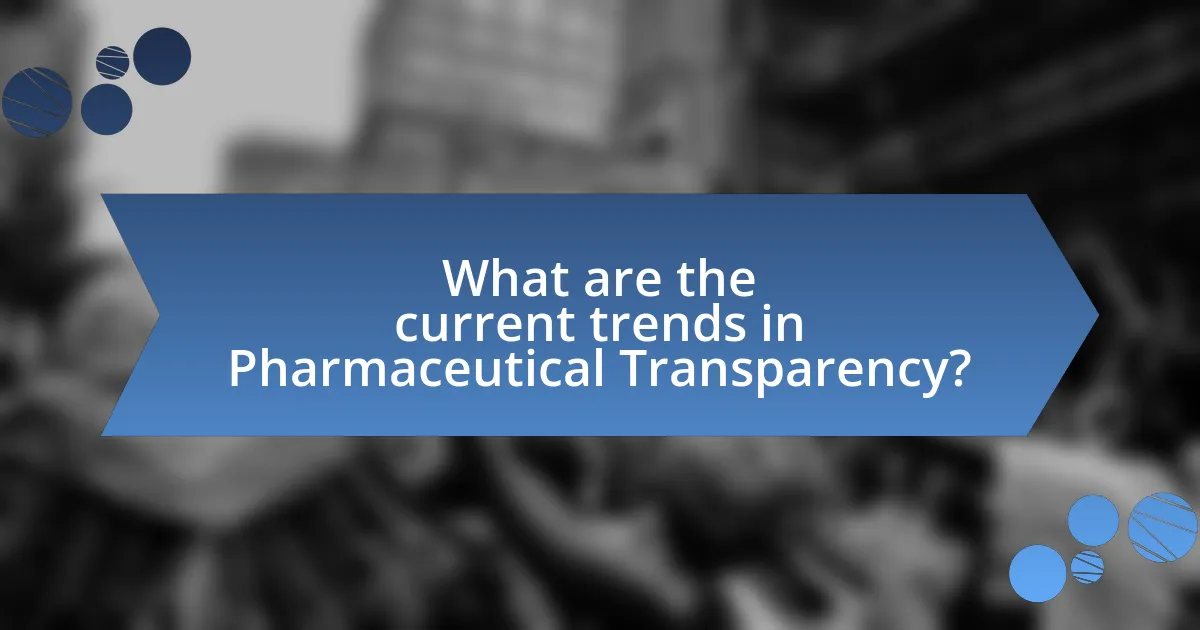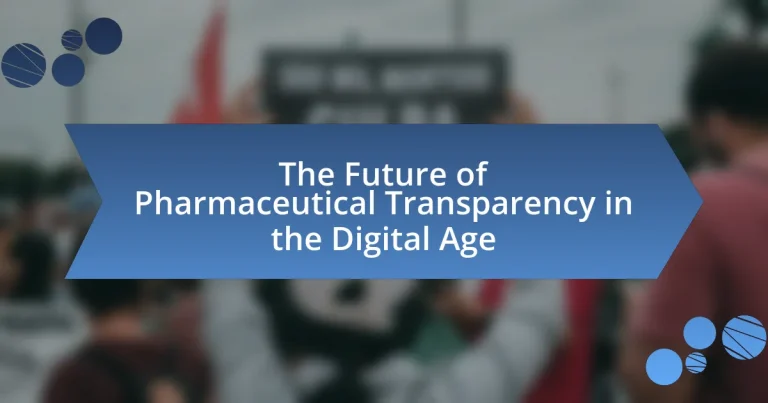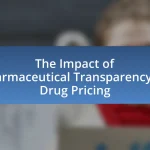Pharmaceutical transparency in the digital age encompasses the open sharing of information related to drug development, pricing, and clinical trial results, facilitated by digital technologies. This article explores the evolution of transparency practices driven by advancements in digital tools, highlighting key components such as clinical trial data disclosure, pricing transparency, and communication of drug safety. It examines the role of technologies like blockchain and data analytics in enhancing transparency, the importance of transparency for stakeholders, and the challenges faced by the pharmaceutical industry. Additionally, the article discusses current trends, future outlooks, and best practices for fostering a culture of transparency within organizations, ultimately aiming to improve patient trust and safety in healthcare.

What is Pharmaceutical Transparency in the Digital Age?
Pharmaceutical transparency in the digital age refers to the open sharing of information regarding drug development, pricing, and clinical trial results, facilitated by digital technologies. This transparency aims to enhance accountability and trust among stakeholders, including patients, healthcare providers, and regulatory bodies. For instance, the implementation of platforms like ClinicalTrials.gov allows public access to clinical trial data, promoting informed decision-making. Additionally, the rise of digital health technologies enables real-time tracking of drug pricing and availability, further supporting transparency efforts.
How has the concept of pharmaceutical transparency evolved with digital advancements?
The concept of pharmaceutical transparency has evolved significantly with digital advancements by enabling real-time access to drug information and fostering greater accountability among pharmaceutical companies. Digital platforms, such as online databases and mobile applications, allow patients and healthcare professionals to access comprehensive data on drug efficacy, side effects, and pricing, which enhances informed decision-making. For instance, the introduction of the FDA’s Drug Approval Database and initiatives like OpenFDA provide public access to drug approval documents and adverse event reports, promoting transparency. Additionally, social media and digital communication channels facilitate direct engagement between pharmaceutical companies and the public, allowing for immediate feedback and increased scrutiny of practices. This shift towards digital transparency is supported by the growing demand for accountability in healthcare, as evidenced by surveys indicating that over 70% of patients prefer access to detailed drug information online.
What are the key components of pharmaceutical transparency?
The key components of pharmaceutical transparency include disclosure of clinical trial data, pricing transparency, and clear communication of drug safety and efficacy. Disclosure of clinical trial data ensures that results are accessible to healthcare professionals and the public, fostering trust and informed decision-making. Pricing transparency allows patients and providers to understand drug costs, which can influence treatment choices and healthcare spending. Clear communication of drug safety and efficacy involves providing comprehensive information about potential side effects and benefits, enabling patients to make informed choices about their medications. These components collectively enhance accountability and trust in the pharmaceutical industry.
How do digital tools enhance transparency in the pharmaceutical industry?
Digital tools enhance transparency in the pharmaceutical industry by enabling real-time data sharing and improving access to information regarding drug development, pricing, and clinical trials. Technologies such as blockchain provide secure and immutable records of transactions, ensuring that stakeholders can verify the authenticity of drug supply chains. Additionally, platforms that aggregate clinical trial data allow for greater public access to research findings, fostering accountability and informed decision-making among healthcare professionals and patients. For instance, the FDA’s use of digital platforms to publish clinical trial results has increased visibility into drug efficacy and safety, thereby promoting trust in pharmaceutical companies.
Why is pharmaceutical transparency important for stakeholders?
Pharmaceutical transparency is crucial for stakeholders because it fosters trust, enhances accountability, and promotes informed decision-making. When pharmaceutical companies disclose information about drug pricing, clinical trial results, and safety data, stakeholders, including healthcare providers, patients, and regulators, can make better choices regarding treatment options. For instance, a study published in the Journal of Medical Ethics found that transparency in clinical trial data significantly improves patient outcomes by allowing healthcare professionals to assess the efficacy and safety of medications more accurately. This level of openness not only supports ethical practices but also encourages competition and innovation within the industry, ultimately benefiting public health.
What role does transparency play in patient trust and safety?
Transparency is crucial in fostering patient trust and ensuring safety in healthcare. When healthcare providers openly share information about treatment options, risks, and outcomes, patients are more likely to feel empowered and confident in their care decisions. Studies indicate that transparency can lead to improved patient satisfaction and adherence to treatment plans, as patients who understand their health conditions and treatment processes are more engaged in their care. Furthermore, transparent communication about medical errors or adverse events can enhance safety by encouraging a culture of accountability and continuous improvement within healthcare organizations. This approach not only builds trust but also contributes to better health outcomes, as patients are more likely to report concerns and participate actively in their care when they feel informed and valued.
How does transparency impact regulatory compliance and corporate accountability?
Transparency enhances regulatory compliance and corporate accountability by fostering trust and enabling oversight. When pharmaceutical companies disclose information regarding their practices, financials, and clinical trial results, they create an environment where stakeholders can hold them accountable. For instance, the implementation of the Sunshine Act in the United States mandates transparency in financial relationships between pharmaceutical companies and healthcare providers, which has led to increased scrutiny and compliance with ethical standards. This regulatory framework demonstrates that transparency not only aids in meeting legal requirements but also promotes ethical behavior, ultimately benefiting public health and safety.

What are the current trends in Pharmaceutical Transparency?
Current trends in pharmaceutical transparency include increased disclosure of drug pricing, enhanced reporting of clinical trial results, and greater accessibility of information regarding drug safety and efficacy. Regulatory bodies, such as the FDA and EMA, are implementing stricter guidelines that require pharmaceutical companies to publish clinical trial data, which fosters accountability and informed decision-making among healthcare providers and patients. Additionally, the rise of digital platforms enables real-time sharing of information, allowing stakeholders to access comprehensive data on drug performance and pricing, thereby promoting a more transparent pharmaceutical landscape.
How are technology and data analytics shaping transparency practices?
Technology and data analytics are significantly enhancing transparency practices by enabling real-time access to information and fostering accountability within organizations. For instance, blockchain technology provides an immutable ledger that ensures the traceability of pharmaceutical products, thereby reducing fraud and ensuring compliance with regulations. Additionally, data analytics tools allow companies to analyze vast amounts of data to identify patterns and trends, which can be shared with stakeholders to demonstrate ethical practices and decision-making processes. According to a report by the World Health Organization, the implementation of these technologies can lead to a 30% increase in transparency in supply chain operations, thereby improving trust among consumers and regulatory bodies.
What technologies are being utilized to improve transparency?
Blockchain technology is being utilized to improve transparency in the pharmaceutical industry. By providing a decentralized and immutable ledger, blockchain enables secure tracking of drug supply chains, ensuring that all transactions are transparent and verifiable. For instance, a study published in the journal “Frontiers in Pharmacology” highlights how blockchain can enhance traceability and accountability in drug distribution, reducing the risk of counterfeit medications. Additionally, data analytics tools are employed to analyze and visualize data related to drug pricing and clinical trials, further promoting transparency by making information accessible to stakeholders.
How do data analytics contribute to better decision-making in pharmaceuticals?
Data analytics significantly enhance decision-making in pharmaceuticals by providing actionable insights derived from vast datasets. These insights enable pharmaceutical companies to identify trends in drug efficacy, optimize clinical trial designs, and improve patient outcomes. For instance, a study published in the Journal of Pharmaceutical Innovation highlighted that companies utilizing data analytics in their R&D processes reduced time-to-market for new drugs by up to 30%. Furthermore, predictive analytics can forecast market demands and patient needs, allowing for more strategic resource allocation and inventory management. This data-driven approach not only streamlines operations but also fosters innovation, ultimately leading to more effective therapies and improved healthcare delivery.
What challenges does the pharmaceutical industry face regarding transparency?
The pharmaceutical industry faces significant challenges regarding transparency, primarily due to regulatory complexities, proprietary information concerns, and public trust issues. Regulatory complexities arise from varying laws across countries that dictate what information must be disclosed, often leading to inconsistent practices. Proprietary information concerns involve companies’ reluctance to share data that could compromise competitive advantages, such as drug formulation and pricing strategies. Public trust issues stem from historical scandals and perceived lack of accountability, which can hinder open communication about drug efficacy and safety. For instance, a 2020 survey by the Pew Research Center indicated that only 34% of Americans trust pharmaceutical companies to act in the public’s best interest, highlighting the need for improved transparency to rebuild trust.
What are the barriers to achieving full transparency in the pharmaceutical sector?
The barriers to achieving full transparency in the pharmaceutical sector include proprietary information concerns, regulatory complexities, and the influence of financial interests. Proprietary information concerns arise as companies often view their research and development data as trade secrets, limiting the disclosure of critical information. Regulatory complexities, such as varying laws across countries, create challenges in standardizing transparency practices. Additionally, financial interests, including the influence of pharmaceutical companies on research funding and publication bias, can hinder unbiased reporting of drug efficacy and safety. These factors collectively obstruct the path toward full transparency in the sector.
How do privacy concerns affect transparency initiatives?
Privacy concerns significantly hinder transparency initiatives by creating barriers to the sharing of information. In the pharmaceutical sector, companies often face regulatory restrictions that prioritize patient confidentiality over the disclosure of clinical trial data and drug pricing. For instance, the Health Insurance Portability and Accountability Act (HIPAA) in the United States imposes strict guidelines on the handling of personal health information, which can limit the extent to which companies can be transparent about their research and pricing strategies. This tension between the need for transparency and the obligation to protect individual privacy can lead to incomplete disclosures, ultimately undermining public trust and accountability in the industry.

What is the future outlook for Pharmaceutical Transparency?
The future outlook for pharmaceutical transparency is increasingly positive, driven by advancements in technology and regulatory changes. As digital tools and platforms evolve, they enable better access to drug pricing, clinical trial data, and manufacturing processes, fostering greater accountability within the industry. For instance, the implementation of the Drug Pricing Transparency Act in various regions mandates pharmaceutical companies to disclose pricing information, which enhances consumer awareness and trust. Additionally, the rise of blockchain technology offers secure and transparent tracking of drug supply chains, further promoting integrity and reducing fraud. These developments indicate a trend toward a more open and transparent pharmaceutical landscape, ultimately benefiting patients and healthcare providers alike.
How will emerging technologies influence pharmaceutical transparency in the coming years?
Emerging technologies will significantly enhance pharmaceutical transparency by enabling real-time data sharing and improving traceability throughout the supply chain. Technologies such as blockchain can provide immutable records of drug manufacturing and distribution, ensuring that stakeholders have access to accurate information regarding product origins and handling. For instance, a study published in the Journal of Medical Internet Research highlights that blockchain can reduce counterfeit drugs by 30% by allowing consumers to verify the authenticity of medications. Additionally, artificial intelligence can analyze vast amounts of data to identify patterns in drug efficacy and safety, further informing stakeholders and regulatory bodies. These advancements will foster greater accountability and trust in the pharmaceutical industry, ultimately benefiting patients and healthcare providers.
What role will artificial intelligence play in enhancing transparency?
Artificial intelligence will play a crucial role in enhancing transparency by enabling real-time data analysis and improving access to information. AI algorithms can process vast amounts of data from clinical trials, regulatory submissions, and market activities, allowing stakeholders to gain insights into drug development processes and outcomes. For instance, AI can identify patterns in adverse event reporting, thereby increasing the visibility of drug safety profiles. Additionally, AI-driven platforms can facilitate the sharing of research findings and clinical data, fostering collaboration among pharmaceutical companies, regulators, and healthcare providers. This increased accessibility to information supports informed decision-making and builds trust within the healthcare ecosystem.
How might blockchain technology revolutionize data sharing in pharmaceuticals?
Blockchain technology can revolutionize data sharing in pharmaceuticals by providing a secure, transparent, and immutable ledger for all transactions and data exchanges. This technology enables real-time access to verified data among stakeholders, including manufacturers, regulators, and healthcare providers, thereby enhancing trust and collaboration. For instance, a study published in the Journal of Medical Internet Research highlights that blockchain can improve traceability in drug supply chains, reducing counterfeit drugs by ensuring that every transaction is recorded and verifiable. Additionally, the use of smart contracts on blockchain can automate compliance processes, ensuring that all parties adhere to regulations without the need for intermediaries, thus streamlining operations and reducing costs.
What best practices can pharmaceutical companies adopt to improve transparency?
Pharmaceutical companies can improve transparency by implementing robust data-sharing policies, enhancing communication with stakeholders, and adopting standardized reporting practices. By establishing clear guidelines for sharing clinical trial data and results, companies can foster trust and accountability. For instance, the AllTrials initiative advocates for the registration and reporting of all clinical trials, which has been shown to increase public confidence in pharmaceutical research. Additionally, engaging with patients and healthcare professionals through open forums and regular updates can further enhance transparency. The adoption of standardized reporting formats, such as those recommended by the International Committee of Medical Journal Editors, ensures consistency and clarity in disseminating information, thereby reinforcing the credibility of pharmaceutical companies.
How can companies effectively communicate transparency efforts to stakeholders?
Companies can effectively communicate transparency efforts to stakeholders by utilizing clear, consistent messaging across multiple channels. This approach includes publishing detailed reports on business practices, engaging in open dialogue through social media, and hosting regular stakeholder meetings to discuss transparency initiatives. For instance, a study by the Global Reporting Initiative found that organizations that disclose sustainability practices see a 20% increase in stakeholder trust. By providing accessible information and actively involving stakeholders in discussions, companies can foster a culture of transparency that enhances credibility and strengthens relationships.
What strategies can be implemented to foster a culture of transparency within organizations?
To foster a culture of transparency within organizations, leaders should implement open communication practices, encourage feedback, and utilize technology for information sharing. Open communication practices involve regular updates and discussions about company goals, challenges, and successes, which can enhance trust among employees. Encouraging feedback allows employees to voice concerns and suggestions, creating an environment where transparency is valued. Utilizing technology, such as collaborative platforms and dashboards, can facilitate real-time access to information, making it easier for employees to stay informed and engaged. Research indicates that organizations with high transparency levels experience increased employee satisfaction and retention, as seen in a study by the Harvard Business Review, which found that transparent companies are 30% more likely to retain employees.
What practical steps can patients take to ensure they are informed about pharmaceutical transparency?
Patients can ensure they are informed about pharmaceutical transparency by actively seeking information from credible sources, such as government health agencies, academic journals, and reputable health organizations. Engaging with these sources allows patients to access data on drug pricing, clinical trial results, and safety reports, which are essential for understanding the pharmaceutical landscape. For instance, the U.S. Food and Drug Administration (FDA) provides comprehensive information on drug approvals and safety alerts, while the National Institutes of Health (NIH) offers access to clinical trial registries. Additionally, patients can participate in discussions on platforms that focus on healthcare transparency, such as online forums or social media groups dedicated to patient advocacy. By utilizing these resources, patients can make informed decisions regarding their medications and healthcare options.


